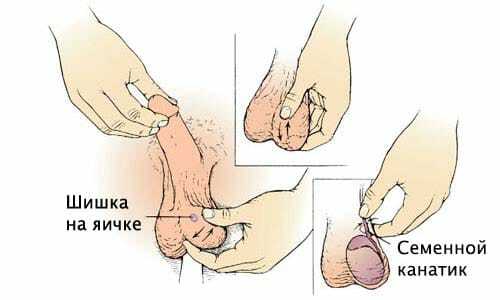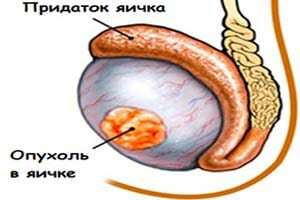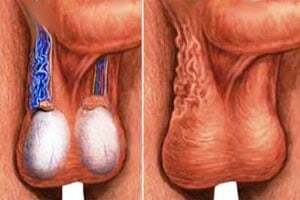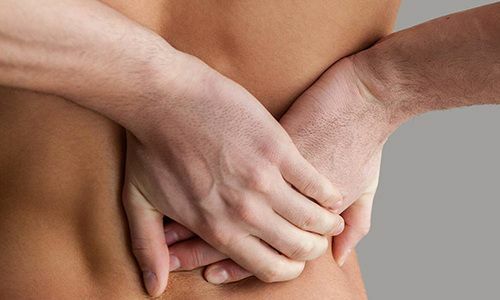The slightest changes in the scrotum cause men to be seriously worried, because such signs can arise as a result of injuries, infectious or inflammatory processes. A bump on a testicle in men is one such change. It can cause discomfort, excitement and physical discomfort. Most often such a growth is spermatoceles, but only a qualified urologist can determine such a syndrome.

Spermatocel is a cavity that is located in the testicle or its appendage, filled with a mixture of spermatozoa and spermatocytes. Such a disease can occur at any age or has an innate origin.
Causes of the disease
The seed cyst, as the spermatocel is also called, with the innate nature of the origin, is formed from the ducts of the Müllerian glands. Such congenital cysts usually do not grow to large sizes, limited to 2-2.5 cm. Such a bump on the testicles in men is usually filled with a liquid of a light yellow hue that does not contain sperm.
If the spermatoceles are acquired, its causes can be caused by inflammatory-infectious scrotal pathologies such as orchitis, epididymitis, vesiculitis, deferentitis, etc. Also, spermatoceles can result from a traumatic factor. As a result, the ducts stop functioning normally, the secret is not output, but accumulates inside, stretching the duct and forming a cystic formation. Acquired seed cysts come in a variety of sizes and differ in the structural structure and nature of the contents. Inside the cyst, there may be a liquid or thick substance that is transparent or milky with impurities of seminal cells and spermatozoa.
Most often, spermatoceles occur in men during periods of age-related changes in the fat-lumpy sphere - at 6-14 years old and 40-50 years of age.
Clinical features of the spermatocele
 Often the spermatoceles begin to develop latently, but eventually the cone reaches a noticeable size and is easily detected by a man when probing the scrotum. If the disease is started, the lump grows to a serious size, can make walking difficult, interfere with the process of sexual intimacy and is accompanied by painful discomfort.
Often the spermatoceles begin to develop latently, but eventually the cone reaches a noticeable size and is easily detected by a man when probing the scrotum. If the disease is started, the lump grows to a serious size, can make walking difficult, interfere with the process of sexual intimacy and is accompanied by painful discomfort.
Usually patients independently detect a pineal formation on a testicle and, being afraid of a cancer tumor, address to the urologist. During the diagnosis, the specialist palpates a smooth and elastic oval or spherical seal, usually not causing pain. However, you can probe only a fairly large seed cyst, although it does not appear externally. To clarify the diagnosis, sometimes a man is assigned magnetic resonance imaging or ultrasound, diaphanoscopy, etc.
Methods of therapy and prevention
Usually, for latent spermatoceles and small cones, specialists choose observational tactics. The patient periodically visits a urologist who monitors changes in the size of the seed cyst. If the scrotum begins to swell, painful discomfort arises, or if the swollen genitals interfere with walking, the operative effect is applied. In general, the therapeutic process of the spermatoceles is composed of the following treatment options:
- Resection of the spermatic cyst by surgery;
- Anesthetic therapy, presupposing the use of anti-inflammatory and analgesic drugs;
- Spermatocelectomy or removal of education. The procedure is a microsurgical process with the extraction of the seed cyst, after which the extracted tissues are necessarily subjected to histological examination.
After surgery, the patient is given a suspension that is necessary for additional support of the scrotum, and it is recommended to apply cold to avoid swelling and to avoid bruising. Over time, the patient has visible defects, reproductive function is restored.
Other causes of scrotal formation
Significantly less often the appearance of a pineal build-up on the testicles occurs for other reasons, such as testicular cancer, inguinal hernia, hematocoel or hydrocele, lymphadenitis or varicocele, etc. These causes are significantly different, so they need to be considered separately.
Oncological processes
 Tumor processes in the tissues of the testicle can also be manifested by the appearance of a cone. Oncoprocesses can be of a malignant or benign nature, as well as a hormone-producing or non-hormone-producing form. One such oncology is testicular cancer, which is quite rare in men 15-35 years of age.
Tumor processes in the tissues of the testicle can also be manifested by the appearance of a cone. Oncoprocesses can be of a malignant or benign nature, as well as a hormone-producing or non-hormone-producing form. One such oncology is testicular cancer, which is quite rare in men 15-35 years of age.
Along with the appearance of cones on the testicles, the patient experiences soreness in the testicle, a dull pain syndrome in the lower abdominal region, heaviness in the scrotum, etc. Gradually, swelling develops, which leads to a noticeable increase in the scrotum. Usually for the oncology process in the testicle, the irradiation of the pain syndrome in the sacro-lumbar region, the groin or the perineum, is typical. The benefit of the prognosis depends on the timeliness of the diagnosis and treatment.
Herniated process
Sometimes men experience a weakening of the peritoneum muscle tissue, which results in hernial lowering into the inguinal region. Such a lowering may be due to traumatic factors, intense coughing or increased physical exertion. Sometimes the hernial processes become a bump on the surface of the testicle. When pressing on the scrotum, the formed soft lump can completely disappear, especially when the patient is lying down.
Varicocele, hydrocele, or haematocel
 Sometimes the causes of a pineal gland are associated with varicose enlargement of the testicular veins, resulting from a disruption in the functionality of intravenous valves. Normally, these valves interfere with the return flow, however, with their dysfunction, blood begins to overflow the blood vessels, causing them to expand. As a result, the testicle, usually the left, develops varicocele.
Sometimes the causes of a pineal gland are associated with varicose enlargement of the testicular veins, resulting from a disruption in the functionality of intravenous valves. Normally, these valves interfere with the return flow, however, with their dysfunction, blood begins to overflow the blood vessels, causing them to expand. As a result, the testicle, usually the left, develops varicocele.
Similar pathology is accompanied by the appearance of seals on the testicle, scrotal tenderness, giving off in the groin, an increase in the affected testicle, changes in the sperm test parameters, testosterone deficiency, external changes in the genitals, etc. The patient can not usually detect the varicocele because pronounced manifestations occur in neglectedstages.
The appearance of a cone may be accompanied by a hydrocele - edema testicle. This pathology is most typical for men for 40. It begins with the appearance of a small seal, however, quickly grows into a large formation. Hematocel is also characterized by the appearance of cones on testicles. The seal is a bloody cluster formed by a traumatic factor. Over time, the hematocele is reduced and compacted.
Lymphadenitis
Inflammatory lesions of lymph nodes can also appear as bumps on testicles. Lymphadenitis, affecting the tissues of lymph nodes and vessels, is initially characterized by the appearance of balls on the testicles. In addition, pathology can lead to the formation of all sorts of tumors inside the testicle.
What should I do when a cone appears?
The approach to therapy is conditioned by the genesis of the cone that appears on the testicles. Only with a competent diagnostic study, a specialist will be able to accurately determine the root cause of such an education and pick up the necessary therapeutic tactics.
Prevent such formations and their timely detection of periodic self-examination. For this, it is recommended that a man be more likely to examine and probe the genitals in order to identify probable cones, various seals, tubercles and other intramuscular anomalies. If such seals are found, it is necessary to undergo a urological examination and a consultation of a narrowly specialized specialist.



